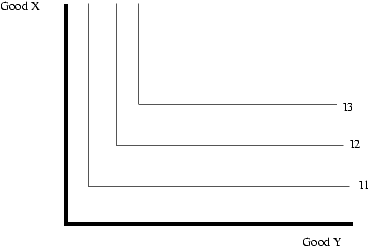Indifference curve
|
|
In microeconomics, an indifference curve is a graph showing combinations of two goods to which an economic agent (such as a consumer or firm) is indifferent, that is, it has no preference for one combination over the other. They are used to analyse the choices of economic agents.
For example, if a consumer was equally satisfied with 1 apple and 4 bananas, 2 apples and 2 bananas, or 5 apples and 1 banana, these combinations would all lie on the same indifference curve.
| Contents |
History
The theory of indifference curves was developed by Edgeworth, Pareto and others in the first part of the 20th century. The theory was developed so that analysis of economic choices could be based upon preferences which can be observed and compared (ordinal utility), rather than the older concept of utility which was based on the unrealistic assumption that the satisfaction derived from economic choices could be measured (cardinal utility).
Indifference Curve Properties
Indifference curves are typically assumed to have the following features:
- An Indifference curve slopes downward from left to right (negative slope). The negative slope is a consequence of the fact that the demand for one commodity (X) increases while the demand for another commodity (Y) decreases (because of diminishing marginal utility of Y), which is necessary to maintain the total satisfaction.
- Indifference curves do not intersect. This is a consequence of the assumption that consumers will always prefer to have more of either good than to have less.
- The curves are convex, which is a consequence of the assumption that as consumers have less and less of one good, they require more of the other good to compensate (corresponding to the law of diminishing marginal utility).
- The Indifference curves are ubiquitous throughout an indifference map. In other words, there exists an indifference curve through any given point on an indifference map.
Indifference Map
For a given pair of goods, many indifference curves can be drawn and placed next to each other. This representation is called an Indifference Map. The rational consumer is expected to prefer the higher or right most Indifference curve, since they represent combinations of goods providing higher levels of consumption.
Assumptions
The first three assumptions are necessary, the next two are convenient.
Rationality: Consumers know their individual preferences and can choose between consumption bundle X and consumption bundle Y. They know either that X is preferred to Y, Y is preferred to X, or that they are indifferent between X and Y.
Consistency: If a consumer chooses bundle X to bundle Y in the first instance, then he cannot choose bundle Y to bundle X in the second instance.
Transitivity: If a consumer prefers bundle X to bundle Y, and prefers bundle Y to bundle Z, then he must prefer bundle X to bundle Z.
Continuity: This means that you can choose to consume any amount of the good. For example, I could drink 11 mL of soda, or 12 mL, or 132 mL. I am not confined to drinking 2 liters or nothing. See also continuous function in mathematics.
Non-satiation: This is the idea that more of any good is always preferred to less.
Convexity: The marginal value a person gets from each commodity falls relative to the other good. In a two good world, if a consumer has relatively lots of one good he would be a happier with a little less of that good and a little more of the other.
Example Indifference Curves
Below is an example of an indifference map having three indifference curves:
The consumer would rather be on I3 than I2, and would rather be on I2 than I1, but does not care where they are on each indifference curve. The slope of an indifference curve, known by economists as the marginal rate of substitution, shows the rate at which consumers are willing to give up one good in exchange for more of the other good. For most goods the marginal rate of substitution is not constant so their indifference curves are curved. The curves are convex to the origin indicating a diminishing marginal rate of substitution.
If the goods are perfect substitutes then the indifference curves will be parallel lines since the consumer would be willing to trade at a fixed ratio. The marginal rate of substitution is constant.
Missing image
Indifference_curve_perfect_sub.png
indifference curve for perfect substitutes
If the goods are perfect complements then the indifference curves will be L-shaped. An example would be something like if you had a cookie recipe that called for 3 cups flour to 1 cup sugar. No matter how much extra flour you had, you still could not make more cookie dough without more sugar. Another example of perfect complements is a left shoe and a right shoe. The consumer is no better off having several right shoes if she has only one left shoe. Additional right shoes have zero marginal utility without more left shoes. The marginal rate of substitution is either zero or infinite.
Application
- Consumer theory uses indifference curves and budget constraints to produce consumer demand curves.
See also
- Consumer Equilibrium
- Price Line
- Bounded rationality
- Homo economicus
- microeconomics
- consumer theory
- budget linecs:Indiferenční křivka
de:Indifferenzkurve fr:Courbe d'indifférence ko:무차별곡선 it:Curve di indifferenza ja:無差別曲線 zh:無異曲線


